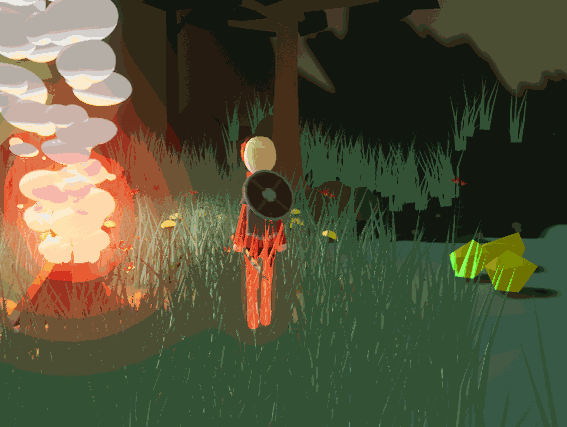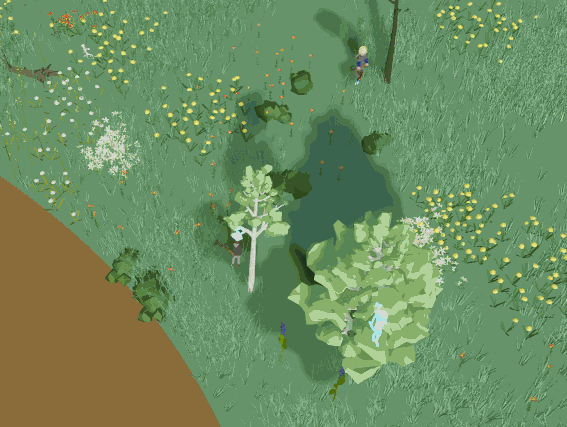My Mind Is Going A Mile An Hour (Part 1)
January 26th, 2023
With our tutorial level completed, we’re working away at designing and implementing an exciting new area for the caravaneers to explore. We figured that this would be a good time to share our techniques in creating AI for the people that inhabit our game. Since the logic for the units in our game has taken the most development effort thus far, there is much to discuss. As such, we will be writing two posts to cover this most interesting topic.
Events and Tick
Both the player’s units and their foes share the same brain. Not exactly the same brain, but they use the same base system of logic to make sense of their environment and produce a plan of action. We knew from the start that we needed to avoid having the units make a lot of decisions in their tick function (ie: updating per frame of animation) due to the performance overhead, so we made things as event driven as possible.
In terms of events, the units will make decisions when their environment changes in some way or when they have completed a job. Some example events are: an enemy moves into a unit’s visual range, a unit has run out of the resource they were harvesting, or when the player manually gives a unit a job. These events cover most every single situation where a unit would need to make a new decision and has proved to be quite performant. Unfortunately there are a few things that do happen in the tick function, such as:
- Update the cooldowns of each unit’s selected action skills
- Update the time remaining and compute any damages that occur from the status effects a unit is afflicted with
- Update the unit’s animation state (More on this in Part 2)
Luckily these things have not proven to be a performance bottleneck.
Eyeballs
Unreal provides a vision system that you can easily add to any character in your game. We originally used this system for prototyping but found that it came with a sizable performance cost due to how much information it was gathering. The Unreal system would see something initially and continually track the thing’s position as long as it was in visual range. We realized that we didn’t need to have this sort of precision in our RTS game. The only thing we needed to know was if something was visible or not; any further information could be gathered at a later time if necessary.
Instead of using Unreal’s vision system, we set the visual range of units to be a sphere centered on them. As the units move around they will see friendly, neutral, hostile, and inanimate-yet-purposeful things. Each of these visible types of things are stored per unit. An example of using this storage is the Cadet’s War Cry skill. When he sees an enemy, he consults his visible enemies list. If more than one enemy is visible he will unleash a war cry that draws the attention of his enemies in an effort to dissuade them from attacking his less armored companions. Another example is the visible, inanimate objects that are stored are used when harvesting resources: when a unit has gathered all of the food from a berry bush, they will check their list of inanimate objects to see if another berry bush is nearby. By having these visible unit and object lists, units can chain together relevant jobs without requiring constant input from the player.

A couple of bandits trying to enjoy a campfire until a pesky combat event occurs
Jobs
When an event occurs that requires a decision, we perform an update of the affected unit’s disposition. This update can cause the unit to stop whatever they’re doing and start a new job, like when an enemy comes into range. The update can also be less important, and may cause a new job to be added to the end of their to-do list.
Jobs are the individual things a unit must do to accomplish their goal. To figure out the jobs required, we work backwards starting from the desired result. One example of this is when the player selects a unit and instructs them to harvest food. The unit will initially receive the harvest job and will then check to see if they are close enough to their harvest target. If they are close enough, the harvest job will be the next thing the unit does. If they are too far, the unit will add a movement job to be performed before the harvest job can occur. A more complex example is when the player selects a unit and instructs them to harvest wood. The job sets for both food and wood gathering are below:
Harvest Food Job Set
- Move to food source
- Harvest
- Deliver food to caravan
- Move back to food source
- If nothing left to harvest, look for another food source
Harvest Wood Job Set
- Move to tree
- Chop wood
- Wait for tree to fall
- Move to chopped wood piece
- Pick up wood
- Deliver wood to caravan
- Move back to wood source
- Look for another piece of chopped wood
- If no chopped wood pieces visible, look for another tree

The harvest wood job set in action. Currently not optimized to select the closest wood piece :)
When harvesting a resource, the units will loop through the set of jobs relevant to the resource type until there are no more resources of that type in visual range. At that time, the unit will become idle and will not perform any further actions until a decision making event occurs or the player manually gives them a job.
Check back in a couple of weeks for the second post on this topic!